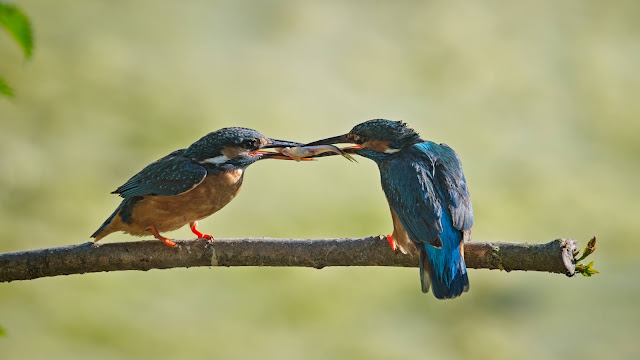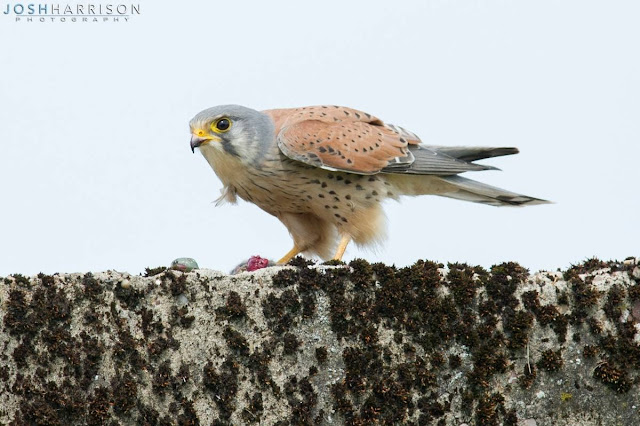Dave Mason:
Unfortunately the much anticipated family line up on the twig didn't occur. Instead they appeared to disperse in every direction. By just after 6am 4 had left the nest.
However after most folks had left a further 17 fish were taken into the nest hole by 14:30 so there must have been one or more still in there. Unfortunately these were never seen leaving - so we can say there were five or more kingfishers fledged, but will never know for sure. However things move quick in the kingfisher world; by the Monday they were clearing out the hole, and by mid week were mating again for brood number 2 - Tony McLean:
We're now awaiting the next hatching - likely around mid June - so it begins again!
Another species having a good year seems to be foxes - earths both on O reservoir - Paul Lyons:
And Hempholme - Thomas Breithaupt:
But not so great for all occupants. Unfortunately the little ringed plovers have not faired so well; They were well on with incubating - doing a great job of defending their nest from all comers - Roy Vincent:
Pete Drury:
But the protective cage was undermined and the eggs disappeared from inside. Clear evidence of scraping and digging could be seen around the perimeter of the cage.
They are perhaps the biggest loss (although still present and hopefully will attempt again); but conspicuous by their absence are the black headed gulls. Most years the cacophony can be heard a good distance away but there is only one deep water moated island with surviving nests this year. In spite of our best efforts to protect the marsh it would seem the foxes have learnt to swim around the defences - Jeff Barker (from a previous year):
The new islands and peninsulas whilst working great for the passage waders and necessary to restore the eroded original landscaping, allows a transit around the marsh once they've made landing - George Stoyle:
So unfortunately its not faring well this season. A late arrival pair of avocets yesterday are unlikely to fair much better at that rate - Roy Vincent:
There's little that can be achieved at this time of year; so this winter we'll have to have a good think about this conundrum. However there is good success on other marshes with lapwing and oystercatcher nesting next door, and the marsh has seen some good results on the spring passage - black-tailed godwit - Frank Moffatt:
Up to 4 ringed plover martin hodges:
Smart wood sandpiper - Frank Moffatt:
At the height of summer there's still some interesting oddments about. Around 5 little gulls in recent days - Frank Moffatt:
Brian Colley:
But the most extravagant show off has been the great white egret - Pete Drury:
Dave Hobson:
Erich Hediger:
A useful comparison with little egret - Martin Hodges:
Many of you will have noticed the South Lagoon drained over this spring; We've been doing a lot of complex work with the water works and environment agency over recent months looking at the water flow through the site. We've just started refilling ready for the summer season to keep south marsh topped up. This will bring oxygen and nutrient rich water into the marsh to arouse the interest of the egrets still further - hopefully right under the hide. Whilst its not always obvious there is a massive amount of work goes on behind the scenes keeping everything optimised for the birds. Certainly the long staying goosander appeared to relish it:Likewise a thorough inspection of the former D res hide has led to the demise of the old south lagoon inlet or 'cattle truck hide'. Rotten legs versus use means this one has been taken out of service and given over to the wildlife. The nest box lads have kitted it out with nesting boxes and bat habitat internally to see out its days.
Again another mixed bag when it comes to vole eaters. The barn owls appeared to be doing well - Tony McLean:
We'd been keeping an eye on them on the new camera set up and were hoping for chicks imminently:
Alas whilst the cameras were off air and after two days of heavy rain the eggs were lost. Presumably the result of a hungry parent.
Tawnies have faired reasonably well - again monitored on camera (although not connected yet) was a nest containing a single chick:
A few days later it had emerged into the open - Darren Smith:
The parents have seldom been far away - Pete Drury:
One chick is not a remarkable tally - and perhaps its not a good vole year? - despite the lingering short eared owl on the approach road - Martin Hodges:
Kestrels though seem to be doing well with the water works pair not far off rearing young - Josh Harrison:Sparrowhawks are active around the site as ever - Roy Vincent:
Marsh harriers bothering the marshes too - Brian Colley:
Seemingly a great success has been the sand martins at long last on the artificial wall - we still need to determine exact figures but certainly looks promising - Roy Vincent:
And Martin Lonsdale:
Swallows too have been very much interested in the new shelves in the reception hide - but yet to commit - Tony McLean:
A fine pair of linnets by Pat Hogarth:
Not popular with all the reserve's passerines - but a welcome barometer of its health for us are the cuckoos back in force again - cracking flight shot by Don Davis:
Breeding success too for the roe deer it would seem - Frank Moffatt:
A busy time in the roe deer calendar - its also rutting season for the bucks now too - Mandy James:
Don Davis:
All happening for marsh frogs too at the moment - Paul Lyons:
But you don't necessarily need a vertebrate to make an appearance - a few recent sightings of the cracking banded demoiselle around site recently - Martin Hodges:
Hairy dragonfly recording record numbers - Martin Hodges:
Common blues - Tony Simpson:
And small coppers - Pat Hogarth:
Moths are a whole tale on their own - best left to the on-going endeavours of Martin on his blog - having recently taken the list north of 645 species with some great endeavours.
Just on the cusp of greatness are the bee orchids - first few emerging now - Roy Vincent:
To follow shortly will be full details of the upcoming 'Water works for Wildlife weekend' to mark the opening of the new hide.
Before that though there is an invite from East Yorkshire Bat Group this week to monitor and learn about the 8 species found at Tophill Low. This Friday the 9th of June at 9pm join Geoff Wilson to listen in and glimpse some of our residents like the uncommon nathusius's pipistrelle, Free with standard admission, no booking necessary.
















































